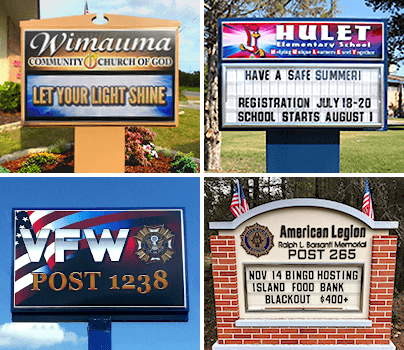
When you're shopping for a new outdoor LED sign, you may have exactly what you want in mind. Your zoning district may have different ideas, however. There are often a number of restrictions organizations have to adhere to before they can post signage. Depending on where your organization operates, you may have certain height restrictions, or you might not be allowed to illuminate your sign at night.
As you're working your way through the LED permitting and zoning process, it's important to have an advocate on your side who understands how to navigate zoning boards' requirements. There are some questions your zoning committee will ask that you may not be able to answer, but an experienced sign expert can step in and answer on your behalf. The following are a few things you should be aware of as they relate to zoning and permitting a new LED sign:
1. Reducing Sign Clutter
Your zoning board may ask why you want an LED sign. There are obvious reasons from your company's perspective, but the board won't be interested in those bullet points. Instead, talk about how your LED sign will enhance the community. LED signs help reduce sign clutter, eliminating eyesores that come with broken down static signs while making use of the valuable real estate on which they reside.
2. Bringing Revenue into Your Community
The idea of revenue and profitability is simple; the more money your community makes, the higher the community's tax base rises. If you're able to advertise your business in a way that gets people's attention, you're more likely to drive traffic to your establishment. An increase in traffic leads to higher sales, which ultimately drive the tax base up. When you explain how your business can enhance the overall health of the community, zoning commissioners are more likely to listen.
3. Being Conscientious of Neighbors
If your zoning committee is concerned about the brightness of your LED display, you're in good hands with Stewart Signs. Our LED signs are completely programmable, meaning they can be set to dim or turn off at a certain time. Once you know the specific zoning requirements, our service team can help you ensure your sign matches the brightness, hold times, and transition settings set forth by your local zoning ordinances.
4. Managing Messaging
Has your district informed you that you can only change your messages every so often? No problem! Stewart Signs LED displays come with software that does whatever you tell it to do. You can change your signs as often or infrequently as your zoning board allows or requires.
5. Examining the Laws
There are times when zoning requirements don't see eye-to-eye with the law. While those occurrences are far and few between, they do happen. If you feel you're being discriminated against, you may need to seek the assistance of an attorney who will help you identify inconsistencies between zoning regulations and federal, state, or local laws, as well as other organizations, which display LED signs that are also against the stipulated regulations.
6. Knowing What to Expect
The permitting and zoning process is a fairly straightforward process, generally speaking. Once you've done your research and decided what type of sign you'd like, you'll need to submit your application. You'll compile the engineers' and contractors' input and send it off to the responsible zoning committee. Usually, you can find the applicable forms online.
Don't be surprised if you're asked questions you're not sure how to answer. Again, this is why it's beneficial to have a sign expert by your side. Experienced contractors and engineers will also help you through the process, but it's best to have industry professionals on your team who can answer questions specific to sign design.
Your Stewart Signs team has been helping our customers find signs that fit their needs for over fifty years. If you're uncertain how to comply with your community's requests, speak with your sign consultant. Our team can create technical drawings, provide installation information, and help you navigate the confusing waters that swirl around permitting and zoning! em>
